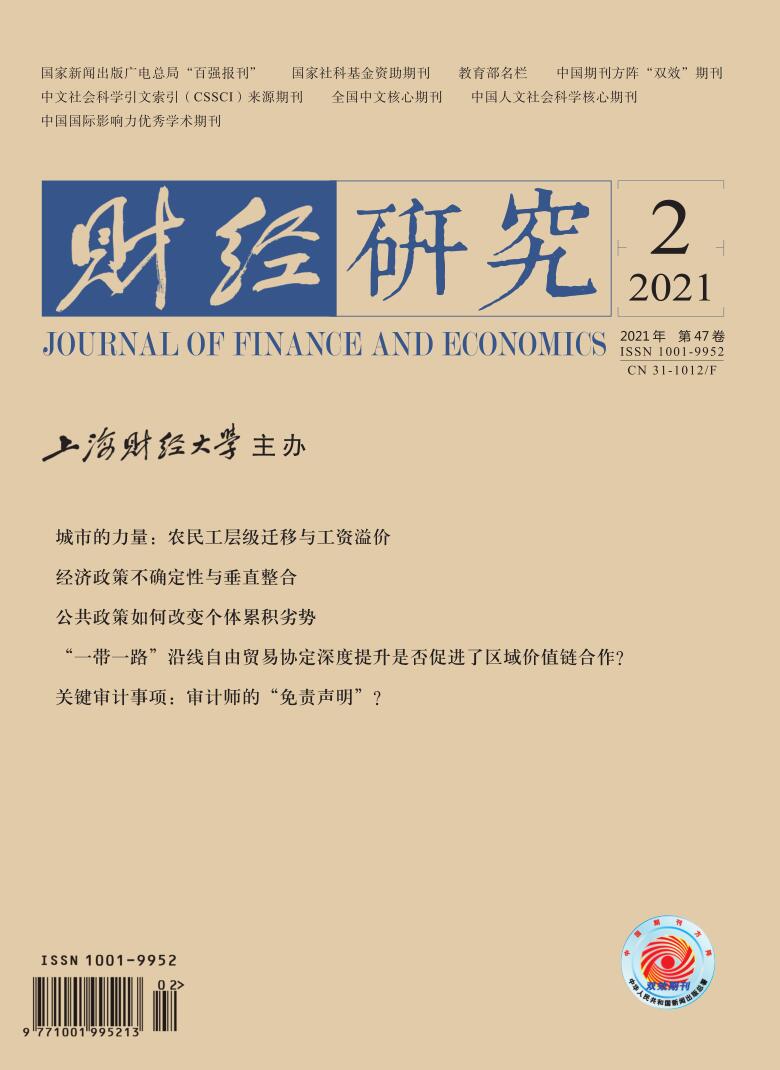“一带一路”国家间的价值链合作是沿线国家化解逆全球化危机、摆脱价值链低端锁定的有效途径,而建立高标准的自由贸易协定可以为沿线的价值链合作提供重要支撑。文章采用2000−2015年64个“一带一路”沿线国家间的数据,实证检验“一带一路”沿线贸易协定深度的提升对区域价值链合作的影响。结果表明:(1)“一带一路”沿线自由贸易协定深度的提升显著地促进了各国在区域内的价值链合作,从多个角度进行稳健性检验后结论依然成立。(2)自由贸易协定深度的提升可以通过降低贸易成本和促进直接投资推动区域价值链合作,其中降低贸易成本是更重要的传导渠道。(3)自由贸易协定中非关税议题和“
“一带一路”沿线自由贸易协定深度提升是否促进了区域价值链合作?
摘要
参考文献
摘要
12 邵朝对,李坤望,苏丹妮. 国内价值链与区域经济周期协同:来自中国的经验证据[J]. 经济研究,2018,(3):187−201. DOI:10.3969/j.issn.1672-5719.2018.03.164
19 Antràs P, Chor D. On the measurement of upstreamness and downstreamness in global value chains[R]. NBER Working Paper No. 24185, 2018.
20 Antràs P,Chor D. Organizing the global value chain[J]. Econometrica,2013,81(6): 2127−2204. DOI:10.3982/ECTA10813
21 Antràs P,Chor D,Fally T,et al. Measuring the upstreamness of production and trade flows[J]. American Economic Review,2012,102(3): 412−416. DOI:10.1257/aer.102.3.412
22 Baier S L,Bergstrand J H. Do free trade agreements actually increase members' international trade?[J]. Journal of International Economics,2007,71(1): 72−95. DOI:10.1016/j.jinteco.2006.02.005
23 Baier S L,Bergstrand J H,Feng M. Economic integration agreements and the margins of international trade[J]. Journal of International Economics,2014,93(2): 339−350. DOI:10.1016/j.jinteco.2014.03.005
24 Boffa M,Jansen M,Solleder O. Do we need deeper trade agreements for GVCs or just a BIT?[J]. The World Economy,2019,42(6): 1713−1739. DOI:10.1111/twec.12766
26 Egger P. Estimating regional trading bloc effects with panel data[J]. Review of World Economics,2004,140(1): 151−166. DOI:10.1007/BF02659714
28 Ghosh S,Yamarik S. Does trade creation measure up?A reexamination of the effects of regional trading arrangements[J]. Economics Letters,2004,82(2): 213−219. DOI:10.1016/j.econlet.2003.06.001
29 Hofmann C, Osnago A, Ruta M. Horizontal depth: A new database on the content of preferential trade agreements[R]. Policy Research Working Paper No. 7981, 2017.
30 Horn H,Mavroidis P C,Sapir A. Beyond the WTO?An anatomy of EU and US preferential trade agreements[J]. World Economy,2010,33(11): 1565−1588. DOI:10.1111/j.1467-9701.2010.01273.x
31 Hummels D,Ishii J,Yi K M. The nature and growth of vertical specialization in world trade[J]. Journal of International Economics,2001,54(1): 75−96. DOI:10.1016/S0022-1996(00)00093-3
32 Johnson R C,Noguera G. Accounting for intermediates:Production sharing and trade in value added[J]. Journal of International Economics,2012,86(2): 224−236. DOI:10.1016/j.jinteco.2011.10.003
33 Koopman R, Powers W, Wang Z, et al. Give credit where credit is due: Tracing value added in global production chains[R]. NBER Working Papers No. 16426, 2010.
34 Koopman R,Wang Z,Wei S J. Tracing value-added and double counting in gross exports[J]. American Economic Review,2014,104(2): 459−494. DOI:10.1257/aer.104.2.459
35 Laget E, Osnago A, Rocha N, et al. Deep trade agreements and global value chains[R]. Policy Research Working Paper No. 8491, 2018.
36 Mattoo A, Mulabdic A, Ruta M, et al. Trade creation and trade diversion in deep agreements[R]. Policy Research Working Paper No. 8206, 2017.
37 Mayer J. The fallacy of composition:A review of the literature[J]. The World Economy,2002,25(6): 875−894. DOI:10.1111/1467-9701.00468
38 Pananond P. Where do We Go from Here?:Globalizing subsidiaries moving up the value chain[J]. Journal of International Management,2013,19(3): 207−219. DOI:10.1016/j.intman.2013.03.002
39 Pomfret R,Sourdin P. Have Asian trade agreements reduced trade costs?[J]. Journal of Asian Economics,2009,20(3): 255−268. DOI:10.1016/j.asieco.2009.02.007
40 Wang Z, Wei S J, Yu X D, et al. Charaterizing global value chains: Production length and upstreamness [R]. NBER Working Papers No. 23261, 2017.
41 Wang Z, Wei S J, Zhu K F. Quantifying international production sharing at the bilateral and sector levels[R]. NBER Working Papers No. 19677, 2013.
引用本文
彭冬冬, 林珏. “一带一路”沿线自由贸易协定深度提升是否促进了区域价值链合作?[J]. 财经研究, 2021, 47(2): 109-123.
导出参考文献,格式为:
上一篇:企业数字化转型与劳动收入份额
下一篇:数字经济与全球价值链国内链长





 4671
4671  4489
4489

